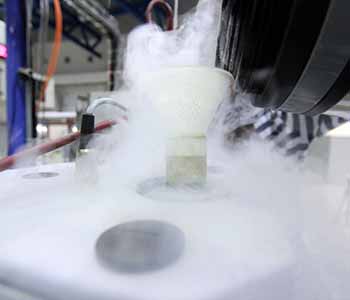Cryopreservation
Cryopreservation is also known as Sperm Banking. The process is used in a variety of different situations. The most common reason for sperm banking is to assure future fertility potential prior to undergoing treatments or medications, such as cancer chemotherapy or radiation therapy, that may eliminate sperm production. Normally, the chance of a woman conceiving in any one month is no more than 20%, whereas, in donor insemination programs using frozen sperm, the monthly chance of pregnancy is approximately one-half that rate. This rate can be directly affected by many factors. The factors include the sperm quality before freezing, how well the sperm survives the freezing and thawing process, how many samples are produced and therefore, how many months of insemination can be performed, and whether or not there are any female infertility factors present. In some of these cases, the sperm quantity or quality may only be sufficient to conceive through use of in vitro fertilization (IVF).

When a vasectomy reversal is performed, the sperm from the site of reconnection can also be used. Please be aware that sperm in the blocked system behind a vasectomy are less mature than ejaculated sperm and cannot penetrate the egg like ejaculated sperm. These sperm can only achieve reliable pregnancy rates when used for in-vitro-fertilization with intracellular sperm injection (IVF-ICSI) in which the sperm are microscopically injected into the eggs.
Due to possible unavoidable sperm damage from the freezing and thawing process, no guarantee can be given that pregnancy will result. The chances for pregnancy using frozen sperm are less than with fresh sperm. After testing, if the initial sample shows low sperm count or movement, you will be notified so as to decide if any further specimens will be frozen, or if that specimen is best used for insemination or IVF.
Cryopreservation is offered in very few vasectomy reversal clinics. If you are considering long-term sperm cryopreservation, discuss these considerations with your doctor.





 Linkedin
Linkedin







